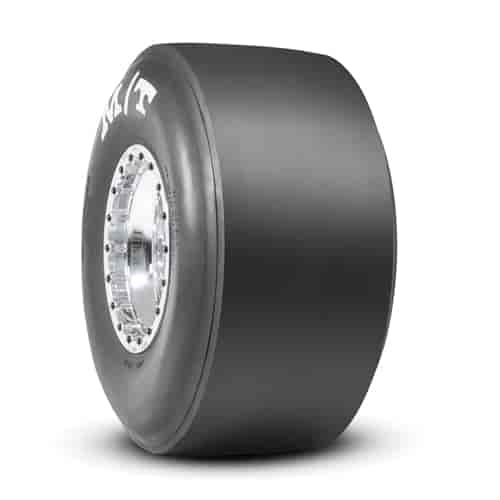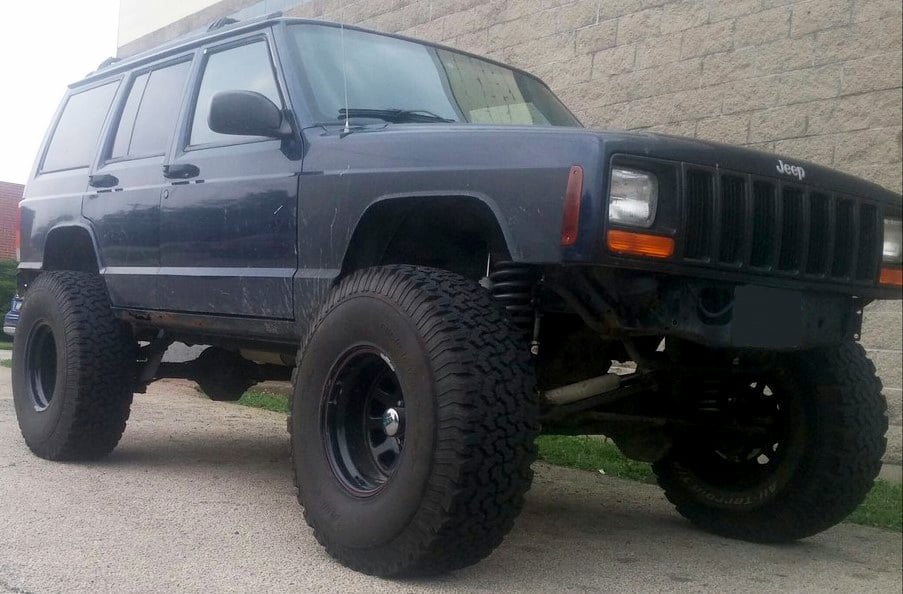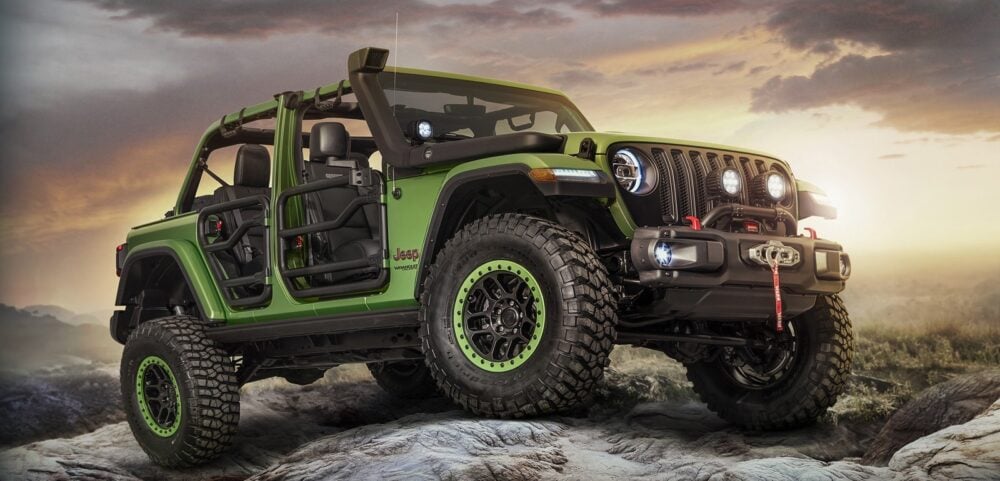
How To Measure Tire Rollout (Circumference)
Roll out is the number of inches the tire rolls before it has traveled back to its initial starting point. A tire can be measured for circumference or roll out by using a tape measure. M/T bias race tires are made with a nylon construction, requiring the proper procedure for checking the rollout when they are first mounted. Mickey Thompson always recommends checking the size before installing rim screws or putting the tires in use. Before mounting the tires, M/T recommends checking the date codes. A natural characteristic of nylon is to shrink over an extended period of time. The dates should be within six months to help ensure close measurements. If they do not, please contact a JEGS representative to help.
Overall Tire Diameter
O.D. (outside diameter) is the measurement of a tire taken from the top of the tire to the bottom of the tire. Note: The O.D. of a tire is measured with the tire off of the wheel. The most accurate way to calculate the OD of a tire is measuring the circumference and dividing by 3.1416”. (Example: Circumference = 88.0” ; therefore 88.0 divided by 3.1416 = 28.01”) Knowing the O.D. of a tire will aid in fitment issues and can assist in gear ratio and speedometer corrections.
Frequently Ask Questions About Tire Roll Out
Drag tires are a very important part of a race car. When purchasing (non-radial) drag tires, it is very important that the rollout matches within 1/2 of an inch between the two rear drag tires. JEGS checks this before shipping tires to you. Tire pressure is also important for drag racing. Below are answers to the most common questions about tire rollout:
What is Tire Roll Out?
Tire rollout is the measured circumference of a tire or the distance a non-radial drag tire rolls before it reaches its original starting point. It is primarily important for drag tires, because each tire can vary slightly when released from the tire mold at the factory. This can cause the rollout to vary when comparing two tires up to 2 inches or more if randomly pulled from a tire rack. Tire roll-out is measured by establishing a measurement starting point on the top and middle of the tire and with a flexible and accurate measuring tape, roll the tire, keeping the measuring tape in the middle, until you reach the beginning of the measurement. This can be done unmounted from the wheel. However, an even more accurate way of measuring per Mickey Thompson is the following:
- Mount the tire to the wheel and inflate it to 20 psi.
- Immediately deflate the tire to race pressure (12 psi for small tires, 6 psi for big tires, or the psi you plan to use).
- Begin the measurement with a flexible measuring tape, centered at the top of the tire. Roll the tire around until your end measurement reaches the starting measurement. This is your tire roll-out. Write down or remember the amount to the closest 1/4 “. Repeat for the other tire.
- If both of your tires are within a 1/2“ of each other, rollout is considered a match.
- If you want to make the tires match closer than 1/2 “ or the tires are not within 1/2 “of each other on rollout, inflate the tire with the smaller rollout to 25 psi and let it sit for a minute or two (don’t let it sit longer to prevent damage). Deflate it completely to zero, then inflate it to race pressure and measure the rollout again.
- If the difference in roll-out between two tires is 3/4 “ or more after trying to stretch the smaller tire, you do not have a match and one of them will need to be swapped out until you have a close enough match. JEGS verifies that all (non-radial) drag tires are within 1/2 “ before shipping them out.
DIAMETER, ROLLOUT (CIRCUMFERENCE) AND REVOLUTIONS PER MILE CHART
Below is a chart to assist in vehicle drive-train calculations from Mickey Thompson Tires.
| Diameter | Rollout | Revs/Mile* |
|---|---|---|
| 17.5 | 55.0 | 1222 |
| 18 | 56.5 | 1186 |
| 18.5 | 58.1 | 1152 |
| 19 | 59.7 | 1120 |
| 19.5 | 61.3 | 1090 |
| 20 | 62.8 | 1061 |
| 22 | 69.1 | 960 |
| 22.5 | 70.7 | 938 |
| 23 | 72.3 | 917 |
| 23.5 | 73.8 | 896 |
| 24 | 75.4 | 877 |
| 24.5 | 77.0 | 858 |
| 25 | 78.5 | 840 |
| 25.5 | 80.1 | 823 |
| 26 | 81.7 | 807 |
| 26.5 | 83.3 | 791 |
| 27 | 84.8 | 776 |
| 27.5 | 86.4 | 761 |
| 28 | 88.0 | 747 |
| 28.5 | 89.5 | 733 |
| 29 | 91.1 | 720 |
| 29.5 | 92.7 | 708 |
| 30 | 94.2 | 695 |
| 30.5 | 95.8 | 684 |
| 31 | 97.4 | 672 |
| 31.5 | 99.0 | 661 |
| 32 | 100.5 | 651 |
| 32.5 | 102.1 | 640 |
| 33 | 103.7 | 630 |
| 33.5 | 105.2 | 621 |
| 34 | 106.8 | 611 |
| 34.5 | 108.4 | 602 |
| 35 | 110.0 | 593 |
| 35.5 | 111.5 | 585 |
| 36 | 113.1 | 576 |
| 36.5 | 114.7 | 568 |
| 37 | 116.2 | 560 |
| 37.5 | 117.8 | 553 |
| 38 | 119.4 | 545 |
| 38.5 | 121.0 | 538 |
| 39.5 | 124.1 | 524 |
| 40 | 125.7 | 517 |
| 45.5 | 142.9 | 453 |
| 46 | 144.5 | 448 |
| 53 | 166.5 | 388 |
| 53.5 | 168.1 | 384 |
| 54 | 169.6 | 381 |
*Based on approximate loaded radius.
What Roll Out Should I Have On My Drag Tire?
If the rollout of both tires is within approximately ½ “of each other, the tires are considered a match. If the difference is between 1/2 “ and 3/4 “, it may be possible to stretch the smaller tire to get the tires to match. See above info on the steps for this process. If the difference in roll-out between the two tires you have is 3/4 “ or more, they are not considered a match and one of them will need to be changed out until you have a pair within 1/2 “roll-out. JEGS offers a wide selection of drag racing tires to meet your race needs and checks all non-radial drag tires to be within 1/2 “ rollout before shipping.
What Tire Pressure is Roll Out Measured at on Mickey Thompson?
Mickey Thompson tire rollout is measured at “race pressure”, which is the psi you plan to use at the track with the tire you are measuring. The below chart will help you with the minimum pressure required, depending on the type of tire. If you used a different brand previously, Mickey Thompson recommends using the psi you used at the track with that brand for roll-out measurement and then adding in 1/2 PSI increments until the best performance is achieved. .
Mickey Thompson Tire Specs:
ET DRAG® AND ET STREET™ R (BIAS)
VEHICLE WEIGHT TIRE SIZE AIR PRESSURE
UNDER 2,500 LBS UNDER 32" DIA 7 P.S.I. AND UP
UNDER 2,500 LBS OVER 32" DIA 5 P.S.I. AND UP
2,500 TO 3,000 LBS UNDER 30" DIA 10 P.S.I. AND UP
2,500 TO 3,000 LBS 30-33" DIA 8 P.S.I. AND UP
2,500 TO 3,000 LBS OVER 33" DIA 5.5 P.S.I. AND UP
OVER 3,000 LBS UNDER 30" DIA 12 P.S.I. AND UP
OVER 3,000 LBS 30-33" DIA 8 P.S.I. AND UP
OVER 3,000 LBS OVER 33" DIA 6 P.S.I. AND UP
- Recommended pressures are guidelines only, actual pressures may vary. Wheelie bar settings are with the front end extended and can vary also.
Can't Find The Tires You Are Looking For?
A JEGS expert is ready to answer your questions and help you find the tires that you require for your specific application.




